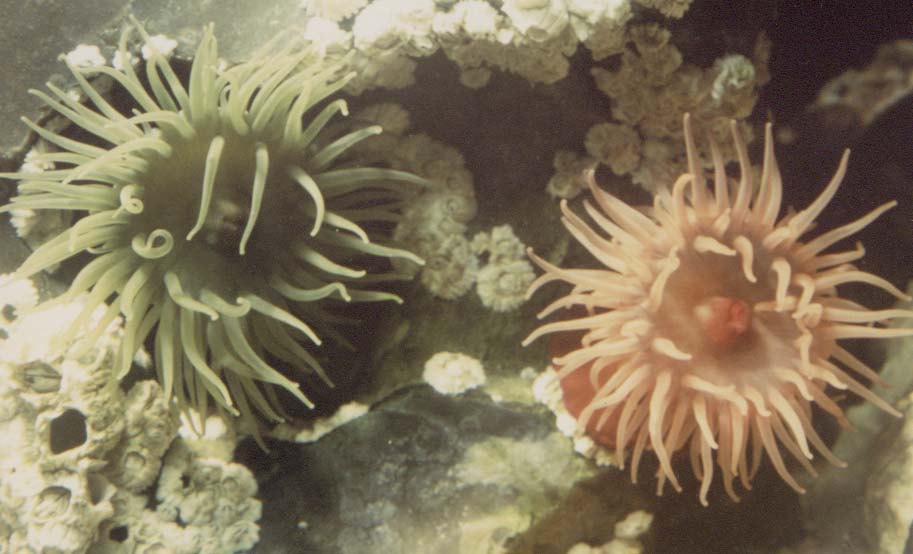
January |
||||||||||||||||||||||||||||||||||||||||||||||||||||||||||||||||||||||||||||||||||||||||||||||||||||||||||||||||||||||||||||||||||||||||||
|
January is mostly too cold to go down to the shore to explore the life in the pools, both for the rockpooler, who can always wrap up in some old winter wear, but more importantly it is also too cold for the seashore life around Britain. All of the rock pool fish and most of the crabs will be resident in the deeper, warmer water. Air temperature is the important factor. An icy northerly wind can quickly cool the pools to near freezing point, and if the temperature of the pools falls to minus 1.87oC the pools will actually freeze. This would be very rare in the south but could conceivably occur in upper shore pools on Scottish coasts. The average air temperature during January is about 2oC on
the eastern English Channel coast and at about 1.5oC on the
North Sea coast with annual fluctuations, but because of the lesser specific
heat of air the temperature can vary much more quickly than the open sea.
In Cornwall the mean air temperature in January has an average of 5oC,
so the fish and crabs may still remain on the shore during this month.
SEA TEMPERATURE The higher specific heat of water compared to air means that the sea will heat up and cool down much more slowly than the air, and during January the sea is likely to be warmer than the air. Although the sea temperatures at the surface vary by a few degrees each year the average sea temperatures at Plymouth in January is 9oC, at Brighton 8oC and at Newcastle only 5.5oC. However, this is higher than the average air temperature. Northern species like the snake-like Butterfish
or Gunnel, Pholis gunnellus, or on the east coast the Eelpout, Zoarces
viviparous, may be found between the tides during January, There are
other factors like the prevalent gales and rainfall that dilutes the pools
that make the shore an inhospitable place for marine fish.
TEMPERATURE AMPLITUDE How does this effect the aquarist? Simply, every organism can only survive between certain temperature tolerances. These are quite often only a narrow range for marine organisms. Because the sea does not vary much in temperature they have not evolved to withstand great variations. Alas, as far as the aquarist is concerned, the temperature in his aquarium
will quickly equal the ambient air temperature unless a heater or cooler
is installed.
RESEARCH Tropical aquarists rarely have any problem with temperature because the retailer should know the optimum temperature in which the fish can live. The variations in the water temperature in the tropics are much smaller. Aquarists keeping British marine life have
to resort to research. This is undertaken in two stages. The first is to
find out the distribution range of the fish or invertebrate in a high quality
identification guide. The second stage is to find out the minimum and maximum
sea temperatures in the sea at the two edges of its distribution range,
and then calculate the range in which the fish can live.
TEMPERATURE VARIATION Even within its natural tolerance fish and other invertebrates are unable
to survive rapid and large variations, over 2oC, in a short
period of time. This is likely to occur when an aquarist is transporting
fish home and putting them in a tank which is significantly warmer or colder
than the bag or bucket in which the fish is being carried. There are just
one or two exceptions like the rock pool fish called blennies which can
withstand a 5oC sudden fall. This may occur in the wild when
the tide comes in and refreshes the pools in which they were living.
TEMPERATURE RELATED VARIABLES Two variables are important to the aquarist: DISSOLVED OXYGEN Sea water becomes saturated with dissolved oxygen and as the temperature
increases the amount it can hold decreases according to the following table:
Higher amounts of dissolved oxygen are found in freshwater. If the gas is not renewed from the atmosphere as quickly as it used up the fish and other animals will suffocate. Stocking levels need to be lower at higher temperatures. The specific gravity of the water decreases with increasing temperature
when the salinity remains constant. The denser water will show a higher
reading on the hydrometer according to the following scale:
The ability of fish to tolerate changes in salinity varies with different
species. Invertebrates, especially sea anemones, will not thrive in reduced
salinities. As a very rough guide a specific gravity reading of 0.001 corresponds
approximately to a 0.1 per cent alteration in salinity, and this variation
is the tolerance limit. Water with a salinity of less than 3.0 per cent
is defined as brackish; and in excess of 3.7 per cent as metahaline, and
likely to be found only in enclosed lagoons.
SEA TEMPERATURE RANGES WORLDWIDE
These temperatures are taken at the surface and cover and in some cases
cover a wide range of ocean. To ascertain the precise requirements of a
particular fish more accurate measurements may be necessary. The sun only
warms the oceans down to depth of 550 metres. As the average depth of the
sea is 3,729 metres, it follows that the great depths are only kept warm
by water circulation and mixing. The abyssal depths are above the vast
ocean plains that cover the ocean floor and vary in temperature between
1oC and 5oC. It is the warmer, shallow waters close
to land over the Continental Shelf that contain most of the marine life.
|
||||||||||||||||||||||||||||||||||||||||||||||||||||||||||||||||||||||||||||||||||||||||||||||||||||||||||||||||||||||||||||||||||||||||||
